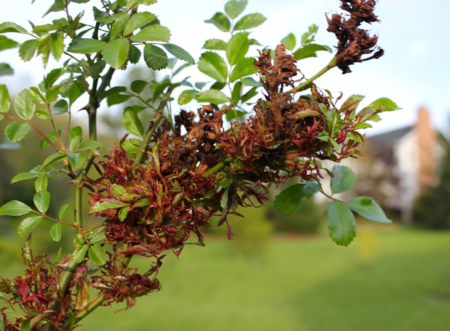INSECT HOT TOPICS: Emerald ash borer update and rose rosette
by James A. Bethke
The emerald ash borer has been moving westward at a relatively slow pace, and when I first mentioned it in this article in 2012, it had reached the eastern end of Kansas. Recently, however, a colleague notified us that a significant population was confirmed in Boulder, Colorado. He commented that it couldn't have picked a worse place. Why? Because it was found smack in the middle of the biggest contiguously growing population of ash trees in the state. What’s worse is that it landed in an area where the folks are pesticide averse, and due to all the hubbub with systemic insecticides and honeybees, it is a white hot flash point. This is very important since the systemic insecticides are university proven, preventative treatments (see the web address below). If systemic insecticides aren’t used, the result will be tree death and removal, or in landscape settings, tree fall. I pass by a great number of newly planted ash trees every day because it was the tree of choice by the landscapers at the Operations Center in San Diego County. I feel it is highly likely that this bug will make it to California some time in the near future and it would pay to be prepared. For more information, see http://www.emeraldashborer.info/files/Multistate_EAB_Insecticide_Fact_Sheet.pdf.
The second issue I would like to address in this article is the increased incidence of rose rosette, which is sweeping the nation with fury. Everyone should be aware of the threat. The causal agent of rose rosette is not a new pest and it is not an insect. It is a virus that is transmitted by an eriophyid mite, Phyllocoptes fructiphilus, a North American native. The mite has either historically or recently been observed widespread in the United States and in Canada. In addition to the mite, the virus disease can spread by infected hand tools, grafting and in infected roots.
The symptoms of rose rosette are not subtle and may have a witch’s broom-like appearance. Symptoms include excessive thorniness, rapid stem elongation, leaf distortion, leaf reddening, leaf chlorosis with a mosaic pattern, abnormally narrow leaflets, thickened stems and premature lateral buds (fig. 1). Unfortunately, there is no cure for rose rosette, and as everyone knows, eriophyids are tough to clean up. Therefore, plant removal and preventive applications of effective miticides to avoid infection will be necessary. Rose plantings downwind of an infected plant, even in outdoor nurseries, are more likely to become infected because eriophyid mites can be blown by the wind or carried by flying insects.

Fig. 1. Rose rosette symptoms in the landscape in Ohio. Photo taken by Denise Ellsworth, director of Ohio Agricultural Research and Development Center's Honey Bee and Native Pollinator Education Program.
Multiflora rose (Rosa multiflora) is extremely susceptible and infection in other rose types has been seen including climbers, hybrid teas, floribundas, miniatures, antique or “old-fashioned” roses, knockouts and carpet rose. Mite populations are most abundant from June through July with the peak occurring in September, and most infection symptoms appear in July and August.
Since the disease can be mechanically transmitted, disinfecting hand tools will prevent contamination. Additionally, rose rosette can be spread or transmitted by grafting. Infected shoots may express the disease as much as 18 months later and serve as an inoculum source. The virus may also be present in the roots of multiflora roses, which means that the remaining roots after the removal of an infected plant may still infect a new planting for an extended period.
Chemical control of eriophyids can be attained using abamectin (Avid), fenproximate (Akari), carbaryl (Sevin) and spiromesifen (Judo). These products can only be used as a preventive measure, not as a curative, and should be rotated to avoid or delay any chance of resistance. If the risk is high in your area, it may pay to make preventive applications.
The American Nursery and Landscape Association (ANLA) has recently developed an informative web page, which is listed below along with a few other sites that you may want to view.
http://anla.org/knowledgecenter/ticker/index.cfm?view=detail&colid=123&cid=378&mid=5698
http://anla.theknowledgecenter.com/OnDemand/index.cfm?view=category&colid=143&cid=377
http://www.greenhousegrower.com/article/32859/reducing-the-spread-of-rose-rosette-disease
http://www.ars.org/about-roses/rose-care-articles/rose-rosette-disease-sadly/
http://www.clemson.edu/extension/hgic/pests/plant_pests/flowers/hgic2109.html
http://entoplp.okstate.edu/pddl/2012/PA11-5.pdf
http://pubs.ext.vt.edu/450/450-620/450-620_pdf.pdf
James Bethke is Farm Advisor for Nurseries and Floriculture, UC Cooperative Extension, San Diego and Riverside Counties.












